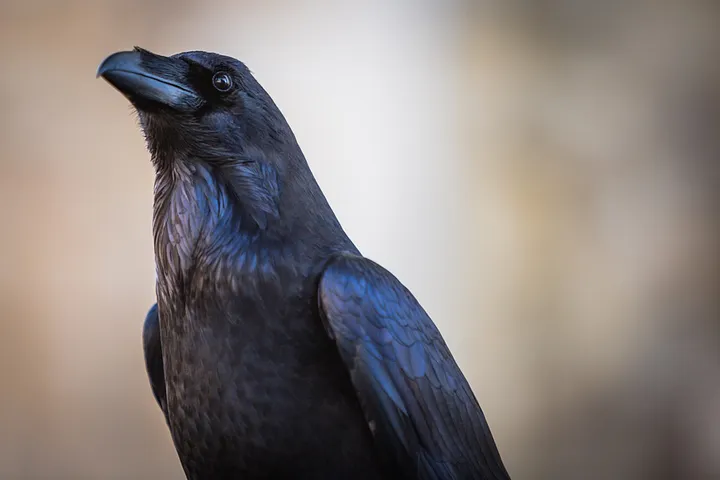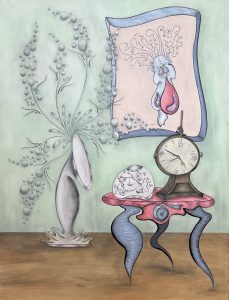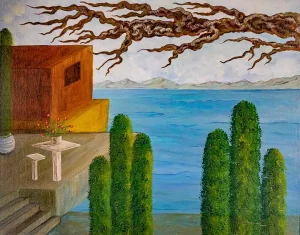History’s Mysteries Part 2 of 4 (Link to Part 1)
Welcome back to our art mysteries series. Let’s begin with a viewpoint on how to approach these questions. From Treasure:
Professor Chatsworth kept talking. “Because we see what we want to see. We impose our desires and our hopes and our personality onto these mysteries. We often refute the evidence–or shrug at the obvious inconsistencies in the stories with which we have been presented.” She advanced the slide to show pages of an aged manuscript. “As the letters on the Shepherd’s Monument remain un-decoded, so does the Voynich Manuscript, dating to the early 15th century.” The beautiful manuscript pages in greens and golds filled the screen. “Using the 240 surviving pages, scholars and cryptographers have still been unable to decipher the language or the writing system. Yet, each expert has applied his or her insight to the pages. Each has his or her own desires for the solution.”
“If we are religious, we wish the answer to be spiritual. If we are a historian, we wish the solution to be one of power, wars, and politics. If we are a botanist, then about plants. If we are rich, then about the aristocracy. And if we are a poor, about the downtrodden. We wish the author or artist to speak to us.”
In the first article in this art history series, we examined mysteries in the fine art world. We return to our History’s Mysteries art series to investigate writers and writing. Let’s set the tone with the father of horror: Poe.
American author Edgar Allan Poe, the father of horror, detective and crime novels, was found in a Baltimore park on October 3, 1849, lying in a gutter, delirious and wearing someone else’s clothing. During his medical care, he repeatedly called out “Reynolds,” but no one knew to whom he was referring.
He died 5 days after he was found, though no one can explain why or how. Brain swelling was the official cause of death. But how did he reach this macabre end?
Could it have been voter fraud? This is not a jest. It was election day when he was found outside a polling place. Theorists believe he might have been the victim of cooping–dressing someone as another, and through forced intoxication, getting the person to then vote for a particular candidate–multiple times. (Sounds like a modern problem…)
Was it alcohol poisoning? Family noted that Poe was a teetotaler as he was battling alcoholism, was a lightweight, a member of a Temperance organization, and refused to touch the stuff after a drunken incident months before. Later tests of his hair showed low levels of lead, so he was sober.
Medical professionals consider it might have been a brain tumor or a lesion. But there is scant evidence for that or the theory that he died from rabies. Perhaps it was mercury poisoning, which Poe had been taking to battle cholera. A hair sample, however, showed no evidence of overdose.
Some say he was poisoned and murdered by the three brothers of Poe’s finance. Some letters and memoirs reference this possibility; the brothers wanted Poe away from their sister. Perhaps, in a vengeful attack, the brothers poured alcohol into him until Poe become despondent?
We are left with insignificant medical tests and no other records. Without direct evidence, we are left with conjecture.
THE BRONTE… MURDERS?
Criminologist James Tully is the author of The Crimes of Charlotte Bronte. As you know, the Bronte sisters were three: Charlotte, who wrote Jane Eyre; Emily, who wrote Wuthering Heights; and the lessor if not at all known Anne, who wrote The Tenant of Wildfell Hall.
According to Tully, Charlotte was so jealous she conspired with her father’s curate, Arthur Bell Nicholls, and poisoned her siblings. Emily and brother Branwell died in 1848. When Anne died in 1849, Charlotte became the sole heir who cashed in on the royalties. She, to her father’s chagrin, then married Arthur Bell Nicholls in 1854.
It was around that time that Charlotte wrote to a friend: “Nell, it is a solemn and strange and perilous thing for a woman to become a wife.” (August 9th, 1854)
Perilous?
Charlotte died in 1855, a year after her marriage, allegedly from typhoid. The child she carried was lost as well. Tully claims all were poisoned and duped by Arthur Bell Nicholls, who was left a rich man.
Critics disagree and argue many died from tuberculosis and most did not live past 26 years old.
You can tour the family home in Haworth Parsonage in Yorkshire, England to look for clues.

The 240 surviving pages of the Voynich Manuscript, dating to the early 15th century, remain indecipherable. The book is full of illustrations and diagrams–beautiful and unintelligible. For years, cryptographers and code breakers have tried to decipher the language to no avail.
Named after one of the owners, the undecipherable language seems to be from left to right–and some of the marginal notes are in Latin, some words within the text are High German. But even those interlines and margin notes do not assist the most adept cryptographer.
The illustrations are unhelpful. The book includes plants, astronomical bodies, nudes, and apothecary items. The text: Maybe shorthand? Maybe written in code? Maybe natural language or a mix of languages? Perhaps it is a fabricated language? Could it be an attempt by a self-proclaimed medium to channel otherworld information? (Too funny.) Or, perhaps, it’s nonsense and merely a hoax.
You can examine the entire document through the digital collections of the Yale University Library. But, if you are like me, plan to spend (squander) the day trying to figure out what the hell this book is about!

THE SHEPHERD’S MONUMENT
Last for this month, we chat about The Shepherd’s Monument in Shugborough Hall, Staffordshire, England. Cryptographers have also struggled with this mysterious engraving. The letters O U O S V A V V imprinted between the letters D and M appear below a mirror-image relief of Nicholas Poussin’s painting, Shepherds of Arcadia.
We know the monument dates between 1748 and 1756. We know the relief was created by sculptor Peter Scheemakers. Within the reproduction of Poussin’s painting, the tomb reads: I am also in Arcadia. And below the relief are those creepy 10 letters.
Charles Dickens and Charles Darwin have tried to break the code. Some have suggested the code leaves directions to recover the Holy Grail. Keith Massey, an NSA linguist, is sure the letters stand for the Latin phrase: “Oro Ut Omnes Sequantur Viam Ad Veram Vitam” (I pray that all may follow the Way to True Life).
Feel free to try to solve this one, although the spokesman for the property was quoted in 2014: “We get five or six people a week who believe they have solved the code, so we are a bit wary of them now.”
MORE TO COME…
But these mysteries are nothing compared to the mystery surrounding Shakespeare. Next month, we will get familiar with Shakespeare, The Bard. Thereafter, we will explore one of the most incredible mysteries in history. See you then!



